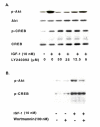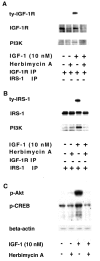Insulin-like growth factor-1 (IGF-1) induces the activation/phosphorylation of Akt kinase and cAMP response element-binding protein (CREB) by activating different signaling pathways in PC12 cells
- PMID: 16792806
- PMCID: PMC1534052
- DOI: 10.1186/1471-2202-7-51
Insulin-like growth factor-1 (IGF-1) induces the activation/phosphorylation of Akt kinase and cAMP response element-binding protein (CREB) by activating different signaling pathways in PC12 cells
Abstract
Background: Insulin-like growth factor-1 (IGF-1) is a polypeptide growth factor with a variety of functions in both neuronal and non-neuronal cells. IGF-1 plays anti-apoptotic and other functions by activating multiple signaling pathways including Akt kinase, a serine/threonine kinase essential for cell survival. The nuclear transcription factor cAMP response element-binding protein (CREB) may also be involved although relationships between these two proteins in IGF-1 receptor signaling and protection is not clear, especially in neuronal cells.
Results: IGF-1, in a concentration- and time-dependent manner, induces the activation/phosphorylation of Akt and CREB in PC12 cells by activating different signaling pathways. IGF-1 induced a sustained phosphorylation of Akt while only a transient one was seen for CREB. The phosphorylation of Akt is mediated by the PI3 kinase pathway while that of CREB is dependent on the activation of both MAPK kinase and p38 MAPK. Moreover, the stimulation of PKC attenuated the phosphorylation of Akt induced by IGF-1 while enhancing that of CREB. Survival assays with various kinase inhibitors suggested that the activation/phosphorylation of both Akt and CREB contributes to IGF-1 mediated cell survival in PC12 cells.
Conclusion: These data suggest that IGF-1 induced the activation of Akt and CREB using distinct pathways in PC12 cells.
Figures









Similar articles
-
High K+ and IGF-1 protect cerebellar granule neurons via distinct signaling pathways.J Neurosci Res. 2004 Mar 15;75(6):794-806. doi: 10.1002/jnr.20024. J Neurosci Res. 2004. PMID: 14994340
-
Comparative signaling pathways of insulin-like growth factor-1 and brain-derived neurotrophic factor in hippocampal neurons and the role of the PI3 kinase pathway in cell survival.J Neurochem. 2004 May;89(4):844-52. doi: 10.1111/j.1471-4159.2004.02350.x. J Neurochem. 2004. PMID: 15140184
-
Insulin-like growth factor-1 induces the phosphorylation of PRAS40 via the PI3K/Akt signaling pathway in PC12 cells.Neurosci Lett. 2012 May 10;516(1):105-9. doi: 10.1016/j.neulet.2012.03.068. Epub 2012 Apr 2. Neurosci Lett. 2012. PMID: 22490886
-
CREB: a stimulus-induced transcription factor activated by a diverse array of extracellular signals.Annu Rev Biochem. 1999;68:821-61. doi: 10.1146/annurev.biochem.68.1.821. Annu Rev Biochem. 1999. PMID: 10872467 Review.
-
PI3-kinase/Akt/mTOR signaling: impaired on/off switches in aging, cognitive decline and Alzheimer's disease.Exp Gerontol. 2013 Jul;48(7):647-53. doi: 10.1016/j.exger.2013.02.025. Epub 2013 Mar 5. Exp Gerontol. 2013. PMID: 23470275 Review.
Cited by
-
The IGF-I receptor can alter the matrix metalloproteinase repertoire of tumor cells through transcriptional regulation of PKC-{alpha}.Mol Endocrinol. 2009 Dec;23(12):2013-25. doi: 10.1210/me.2009-0197. Epub 2009 Oct 23. Mol Endocrinol. 2009. PMID: 19855090 Free PMC article.
-
The Role of MAPK3/1 and AKT in the Acquisition of High Meiotic and Developmental Competence of Porcine Oocytes Cultured In Vitro in FLI Medium.Int J Mol Sci. 2021 Oct 15;22(20):11148. doi: 10.3390/ijms222011148. Int J Mol Sci. 2021. PMID: 34681809 Free PMC article.
-
Molecular Genetics and Pathogenesis of the Floating Harbor Syndrome: Case Report of Long-Term Growth Hormone Treatment and a Literature Review.Front Genet. 2022 May 18;13:846101. doi: 10.3389/fgene.2022.846101. eCollection 2022. Front Genet. 2022. PMID: 35664296 Free PMC article.
-
Regulation of arterial blood pressure by Akt1-dependent vascular relaxation.J Mol Med (Berl). 2011 Dec;89(12):1253-60. doi: 10.1007/s00109-011-0798-3. Epub 2011 Aug 13. J Mol Med (Berl). 2011. PMID: 21842346
-
Novel Synthetic Coumarin-Chalcone Derivative (E)-3-(3-(4-(Dimethylamino)Phenyl)Acryloyl)-4-Hydroxy-2H-Chromen-2-One Activates CREB-Mediated Neuroprotection in Aβ and Tau Cell Models of Alzheimer's Disease.Oxid Med Cell Longev. 2021 Nov 13;2021:3058861. doi: 10.1155/2021/3058861. eCollection 2021. Oxid Med Cell Longev. 2021. PMID: 34812274 Free PMC article.
References
-
- Zheng WH, Kar S, Quirion R. Insulin-like growth factor-1-induced phosphorylation of transcription factor FKHRL1 is mediated by phosphatidylinositol 3-kinase/Akt kinase and role of this pathway in insulin-like growth factor-1-induced survival of cultured hippocampal neurons. Mol Pharmacol. 2002;62:225–233. doi: 10.1124/mol.62.2.225. - DOI - PubMed
-
- Sasaoka T, Rose DW, Jhun BH, Saltiel AR, Draznin B, Olefsky JM. Evidence for a functional role of Shc proteins in mitogenic signaling induced by insulin, insulin-like growth factor-1, and epidermal growth factor. J Biol Chem. 1994;269:13689–13694. - PubMed
Publication types
MeSH terms
Substances
LinkOut - more resources
Full Text Sources
Other Literature Sources
Molecular Biology Databases
Miscellaneous

